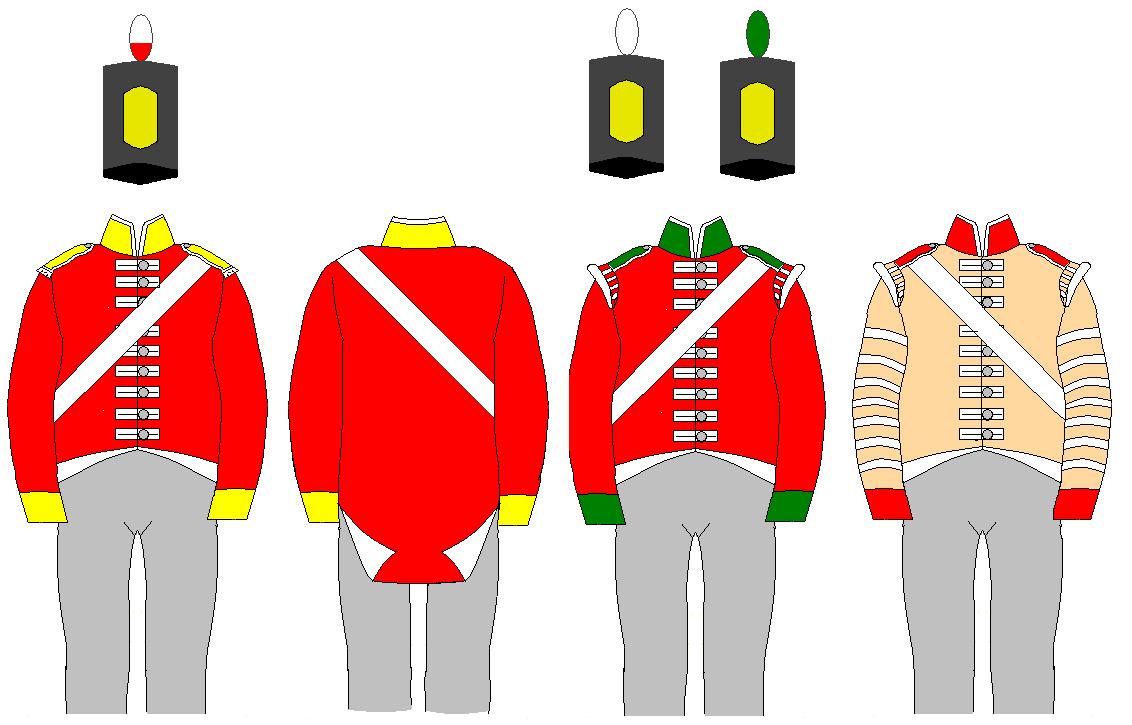BRITISH INFANTRY 1806-1812
The uniform coat for Line and Light infantry regiments was of red cloth, single breasted with small cuffs and turnbacks. The jacket bore regimental facings on collar cuffs and shoulder straps. Lacing was applied across the chest in white or yellow. The lacing could be square ended or ‘bastion’ ended. (See example on the Foot Artillery section).
Each regiment contained two ‘flank companies’; one each of Light Infantry and Grenadiers. The members of these bore red wings with white lace and a white worsted fringe on each shoulder.
The stovepipe shako was worn up to 1812 and for some time beyond that . Centre companies had a white over red plume, Grenadiers a white plume and Lights a green. All shakos bore a large brass regimental badge on the front.
Officers wore long-tailed coats and large bicorne hats. The coats bore the regimental facing colours. Sashes were worn around the waist.
Drummers also had wings and in theory were supposed to wear ‘reversed’ colours, resulting in coats of the regimental facing colour faced with red. In practice this made them very conspicuous targets and the practice was not universal. The coat sleeves bore lace bands or chevrons
Equipment belts were white. The cartridge box was of black leather. The rucksack was brown cowhide with a grey greatcoat strapped to the top.

Line Infantry |
Light Infantry |
Musician |
There were two units of rifle-armed soldiers serving in the British Army. The 95th Regiment and the 5th Battalion of the 60thRegiment both wore 'rifle-green' jackets. All leather equipment was black.
60th Rifles |
95th Rifles |
Facing Colours
There were over 100 regiments in the British army. Each was distinguished
from the other by a combination of facing colour, shape and the spacing
of the lacing on the front of the jacket. Because this is a guide for
painting 6mm figures, the only identifying feature that is really important
is the facing colour.
These were as follows:
BLUE
- 1st (Royal Scots)
- 2nd (Queen's Royal)
- 4th (King's Own)
- 7th (Royal Fusiliers)
- 42nd (Royal Highlanders)
BUFF
- 3rd (East Kent - 'The Buffs')
- 14th (Buckinghamshire)
- 27th (Inniskilling)
- 29th (Worcestershire)
- 31st (Huntingdonshire)
- 40th (2nd Somersetshire)
- 48th (Northamptonshire)
- 52nd (Oxfordshire Light Infantry)
- 61st (South Gloucestershire)
- 62nd (Wiltshire)
- 71st (Highland Light Infantry)
- 81st
GOSLING GREEN
- 5th (Northumberland)
- 36th (Herefordshire)
- 66th (Berkshire)
- 68th (Durham Light Infantry)
YELLOW
- 6th (1st Warwickshire)
- 9th (East Norfolk)
- 20th (East Devonshire)
- 26th (Cameronian)
- 28th (North Gloucestershire)
- 30th (Cambridgeshire)
- 34th (Cumberland)
- 37th (North Hampshire)
- 38th (1st Staffordshire)
- 44th (South Essex)
- 57th (West Middlesex)
- 77th (East Middlesex)
- 82nd (Prince of Wales volunteers)
- 83rd
- 84th (York and Lancaster)
- 85th (Buckinghamshire Light Infantry)
- 88th (Connaught Rangers)
- 91st
- 92nd (Gordon Highlanders)
GREEN
- 11th (North Devonshire)
- 24th (Warwickshire)
- 39th (Dorsetshire)
- 45th (Nottinghamshire)
- 51st (2nd Yorkshire Light Infantry)
- 79th (Cameron Highlanders)
- 87th (Prince of Wales's Own Volunteers)
- 94th
WHITE
- 32nd (Cornwall)
- 43rd (Monmouthshire Light Infantry)
- 47th (Lancashire)
- 59th (2nd Nottinghamshire)
- 74th (Higland)
BLACK
- 50th (West Kent)
- 28th (Rutlandshire)
- 89th